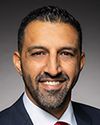Thank you, Mr. Chair.
It's great to be back on the transportation and infrastructure committee this morning. Hello to all of my colleagues.
Since I'm here, I'd like to move my motion that was tabled on February 13, 2023, concerning the need to study the dumping of fill on aerodrome construction sites in Canada.
I'll read the motion, Mr. Chair:
That, pursuant to Standing Order 108(2), the Standing Committee on Transport, Infrastructure and Communities study the Canadian Aviation Regulations pertaining to aerodrome work, with particular focus on: (a) issues that have arisen when individuals and corporations use the pretense of building an aerodrome to lucratively dump fill without regard for municipal and provincial soil laws, including environmental and jurisdictional concerns; (b) the consultation process, including the obligation of proponents to notify interested parties, including municipalities and First Nations communities when aerodrome work is undertaken; (c) the scope of Transport Canada’s review of the Summary Report submitted prior to aerodrome work, including the power granted to the Minister to prohibit aerodrome activity; and (d) what opportunities exist for parties adversely affected by aerodrome developments to raise their concerns with Transport Canada and the responsible Minister.
This requires urgent study. It is very urgent for my community, and I'd like to lay out the comprehensive reasons why.
So that the committee understands, all of the information I'm about to present has been communicated to Transport Canada and the Minister of Transport. There has been no action taken to date.
In the coming months, a general aviation aerodrome was set to be built in my community of Georgina, Ontario, in the small but mighty town of Pefferlaw. The legislative consultation process is now concluded, as has Transport Canada's direct involvement under the Canadian aviation regulations, CARs, from here on.
Despite this, there remain significant concerns that the proponents of this, New Aerodrome Ontario 2021, referred to as the Baldwin east aerodrome project, are using the federally regulated process as a mean to dump significant amounts of soil and fill on the properties of 7818 and 7486 Old Homestead Road. According to the proponent's own disclosures, they plan to dump 1.2 million cubic metres of fill, or 120,000 truck loads, on the site, generating between $12 million and $18 million in revenue.
This practice has already taken place in other communities throughout Ontario, including Greenbank airport, and aerodromes in Scugog, Tottenham and Burlington. In 2014, media reports revealed that federally regulated aerodromes, such as Greenbank airport, were being used as dumping grounds for contaminated dirt and soil. In these cases, federal jurisdiction over aerodrome land was being used to circumvent municipal and provincial soil rules.
At that time, requirements for aerodromes, under part III of the CARs, related only to registered aerodromes or licensed airports. Aerodromes that did not meet the requirements would not be included in Transport Canada publications, but they would not cease to be aerodromes, and, consequently, would remain exclusively within federal government jurisdiction. There is no mechanism for Transport Canada to disallow the establishment of an aerodrome.
In such instances, the dumping of soil occurs under the pretense of expanding or developing an aerodrome, but once that fill is deposited on site, it has now become financially lucrative for proponents. We need to understand that there's a new term: it's now called “cash cropping fill”. That wasn't around 30 years ago.
No further work is undertaken related to the aerodrome itself. The properties become abandoned, and municipalities discover that much of the tonnes of dumped soil is contaminated, which requires significant redemption at a cost to taxpayers and to our environment.
In response to the Greenbank Airport incident, Parliament approved section 143 of the Economic Action Plan 2014 Act, No. 2, which amended the Aeronautics Act to require consultations and allow the Minister of Transport to make an order prohibiting an aerodrome activity or development if it is unsafe or “not in the public interest”. Let me say that again—“not in the public interest”.
This was done so that these sorts of incidents couldn't happen again, but now we are where we are in my community. This has not worked out.
The gatekeepers and bureaucrats at Transport Canada don't care about the many issues surrounding these sorts of proposals, even though significant concerns like those relevant at the Greenbank Airport remained unaddressed. Worse still, the minister has no obligation to act—zero—even when overwhelming evidence is presented to him.
The aforementioned dumping of soil is of foremost concern to residents in my community close to the GTA. One of the proponents, Wilf Goldlust, also owns Triwaste Services and Trillium Recovery, which is subject to a director's order in 2015 proceedings from the Ontario Ministry of the Environment related to illegal fill dumping on a former rail line in Haldimand County. Goldlust was represented by the main proponent, Maurizio Marchioni, during these proceedings.
Despite being built on provincially significant wetlands, a groundwater recharge area, highly vulnerable aquifers and woodlands within the Lake Simcoe watershed, if you can imagine, the aerodrome has been designed to specifically avoid a required assessment by the Environmental Agency of Canada. This is another workaround. The proposed runway lanes are 991 metres, or 3,250 feet, but the agency only considers projects relating to the construction of aerodromes with runways of over 1,000 metres. So here we have a proponent putting out two runways at 991 metres to avoid an environmental assessment.
Both the construction and operation of an aerodrome at this location will have a serious impact on the local environment. In addition, the distinct lack of a business case, and care, for an aerodrome in this area reinforces the impression that the proponents don't actually intend to operate one once dumping a fill has concluded. Prospective pilots—I'm a pilot as well, so I know about these issues and I know about these issues with airports—have numerous and local area concerns. Those concerns are even if Buttonville closes.
Moreover, the proposed lanes of the two paved runways are too short for commercial traffic. Large aircraft that usually utilize instrument landing systems will not be able to do so, meaning that only small aircraft will be able to make use of this aerodrome, significantly limiting economic viability. An airport, if they want to have commercial activity or any viable business plan, is required to have a runway of at least 5,000 feet so that they can put in an ILS.
It's also notable, and this is very strange, that the direction of the runways don't favour northwest prevailing winds, and therefore will lead to unfavourable landing conditions for most pilots, who will constantly look to land elsewhere. As such, the proposed aerodrome lacks significant demand or capabilities to be suitable for recreation or commercial air traffic.
The site of the proposed aerodrome is in a rural area with limited or non-existent access to the required services or infrastructure, meaning there is no water, no sewers, no natural gas and no phase three power.
This is out in an environmentally sensitive area, out in rural Georgina. It's not zoned as commercial. Both of the nearby roads, Morning Glory and Stoney Batter, are insignificant for increased heavy traffic, particularly during the prolonged construction process. These are basically tar and chip roads.
There's also a distinct lack of servicing for the water, sewage and power in the area that would be required should the aerodrome be approved and begin operation. When asked about the business case for this proposal, the proponents refused to answer, saying it was none of the community's business how they planned to operate. Can you imagine someone building an airport and telling the community that it's none of their business to ask these questions?
Finally, the widespread opposition to this proposal across the community needs to be acknowledged. To be clear, the vast majority of this opposition is not from individuals opposed to aerodrome in and of itself. After all, there are many around the area. We have Lindsay. We have Peterborough. There are grass strips in Uxbridge. We have Lake Simcoe Regional Airport. We have Barrie airport.
As an indication of how widespread this opposition in my community is, more than 97% of those participating in the consultation process were against it. E-petition 4213 calling for this project to be denied closed with 2,026 signatures, and we are awaiting a response from government.
This little community of Pefferlaw... I told you it's mighty. There are 3,000 people here, and I can assure you that, if you look at the signatures on the e-petition, the vast majority are from this little community. The town of Georgina, the Lake Simcoe Regional Conservation Authority and the Regional Municipality of York have expressed opposition to or concerns about the project, and the Federation of Canadian Municipalities has issued a resolution expressing concerns about aerodromes being approved so developers can just dump contaminated fill, with municipalities unable to enact their bylaws.
The local first nation, the Chippewas of Georgina Island, whom I am proud to represent.... It is very unusual for first nations to do this, to bring this to the minister's attention. They issued a band council resolution, and I'd like to read this to you. This is band council resolution 02-02-23-1036, from the Chippewas of Georgina Island first nation:
Do hereby resolve: 1. Whereas the construction of a general aviation Aerodrome 'Baldwin East' has been proposed for the property at 7818 and 7486 Old Homestead Rd. and received approval from Transport Canada; 2. And whereas the provisions of the Canadian Aviation Regulations Part III, subpart 307 require that any new aerodrome proposal engage in a consultation process with the local community, but do not require a duty to consult impacted first nations; we insist consultation is addressed with the impacted First Nations; 3. And whereas it is recommended that any proponent seeking a new aerodrome engage in non-mandatory pre-consultation process with the key stakeholders, including local municipalities, in advance of the required consultation process; and whereas Transport Canada has a constitutional duty to consult First Nations when their proposed conduct has potential to adversely impact the First Nations rights; 4. And whereas the aerodrome's proponents did not engage with the Chippewas of Georgina Island in any meaningful or recommended non-mandatory pre-consultation process in advance of the required consultation process; 5. And whereas numerous environmental concerns have been raised about the impact of the aerodrome and related fill dumping will have, including the Lake Simcoe ecosystem; 6. And whereas the proposed aerodrome is on the traditional lands of the Chippewas of Georgina Island, and whereas the proposed aerodrome has the potential to adversely impact the Georgina Island First Nation aboriginal and treaty rights.
Therefore let it be resolved that the Chippewas of Georgina Island First Nation oppose the aerodrome project moving forward. And demand that Transport Canada consult with them on any proposed aerodrome project that they may have an adverse impact on our rights.
Since the CARs were amended in 2014, there have been two uses of the powers granted to the minister to deny the establishment of an aerodrome from proceeding. In 2020, the Minister of Transport issued an order prohibiting the development of an aerodrome in the municipality of Saint-Roch-de-l’Achigan. It was an instance where the proponent had been sent a letter from then-minister Garneau, which outlined serious shortcomings in the demonstration of the economic benefits of the project, while noting the strong opposition from residents.
The other usage of the power was in 2015 when a proposed aerodrome in Mascouche and the Terrebonne was initially approved following Transport Canada's consultation process. The municipalities and the Government of Quebec argued against its approval, citing incompatibility of the project with the minister of the environment guidelines, and the minister prohibited the development thereafter.
Despite all this, Transport Canada continues to maintain that they only look at the aeronautic legitimacy of a proposal. Other considerations, including the viability of a project, local opposition, the background of the proponents and the likelihood of a soil dumping endeavour, etc., all fall outside the remit of this process.
Colleagues, this is a growing problem that we're now facing. It can become an environmental catastrophe for communities. We are here as members of Parliament. I know everyone in this room is here to stick up for their constituents. This is a clear case of the government not listening and the government working badly for Canadians.
I would hope, due this being a growing problem across the country that needs to be seriously looked at.... A study by the Standing Committee on Transport, Infrastructure and Communities will help address these issues.
I think by providing more clarity on the scope of the problem and some solutions that we can give government to correct this legislation, communities like mine and all Canadians can be heard and...the process works for them.
Thank you very much, Mr. Chair.




